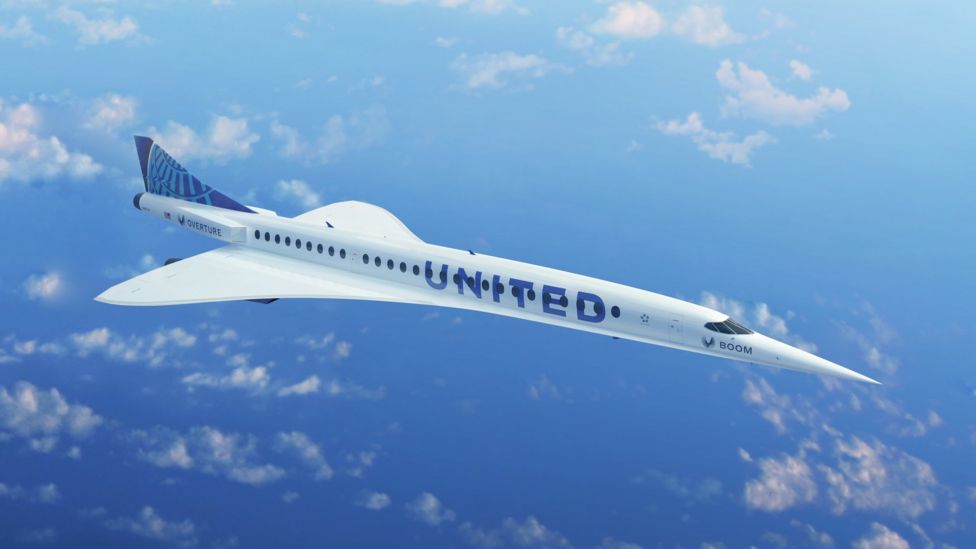United plans supersonic passenger flights by 2029
Central to Boom’s plan is for the airplane to run entirely on sustainable aviation fuel (Saf).
US airline United has announced plans to buy 15 new supersonic airliners and “return supersonic speeds to aviation” in the year 2029.
Supersonic passenger flights ended in 2003 when Air France and British Airways retired Concorde.
What is supersonic flight?
Supersonic flight is when an aircraft travels faster than the speed of sound.
At an altitude of 60,000ft (18,300m), that means flying faster than 660mph (1,060km/h).
A typical passenger jet may cruise at about 560mph (900km/h) but Overture is expected to reach speeds of over 1,122mph (1,805km/h) – also known as Mach 1.7
At that speed, journey times on transatlantic routes such as London to New York can be cut in half.
Boom says Overture would be able to make the trip in 3.5 hours, shaving three hours off the flight.
Concorde, which entered passenger service in 1976, was even faster with a maximum speed of Mach 2.04 – about 1,350mph (2180km/h).

Supersonic air travel has the potential to be sustainable if certain factors are taken into consideration. Here are some ways in which supersonic air travel could be made more sustainable:
1. Fuel Efficiency: Supersonic aircraft should be designed to be highly fuel-efficient. This can be achieved through advancements in engine technology, aerodynamics, and materials used in the construction of the aircraft. By reducing fuel consumption, the carbon emissions associated with supersonic travel can be minimized.
2. Alternative Fuels: Developing and utilizing sustainable alternative fuels, such as biofuels or synthetic fuels, can significantly reduce the carbon footprint of supersonic air travel. These fuels can be produced from renewable sources and have a lower carbon content compared to traditional jet fuels.
3. Noise Reduction: Supersonic aircraft generate a loud sonic boom when breaking the sound barrier, which can have negative environmental impacts. Designing aircraft with noise reduction technologies can help mitigate the disturbance caused by the sonic boom, making supersonic travel more acceptable to communities living near airports.
4. Carbon Offsetting: Even with fuel efficiency improvements, supersonic air travel will still produce carbon emissions. To offset these emissions, airlines can invest in carbon offset projects. These projects aim to reduce or remove carbon dioxide from the atmosphere, such as reforestation efforts or renewable energy projects. By investing in such projects, airlines can achieve carbon neutrality or even a net positive impact on the environment.
5. Limited Routes and Frequencies: To minimize the overall environmental impact, supersonic air travel should be limited to specific routes and frequencies. Focusing on high-demand routes with longer distances can help optimize the utilization of supersonic aircraft while reducing the total number of flights and associated emissions.
It is important to note that while these measures can make supersonic air travel more sustainable, it may still have a higher carbon footprint compared to subsonic flights. Therefore, it is crucial to consider the overall impact on the environment and explore other alternatives, such as improving the efficiency of existing subsonic aircraft or investing in high-speed rail systems.

Is there demand for supersonic travel?
Despite the enormous cost of Concorde’s development more than 50 years ago, it is thought to have been profitable for British Airways in its final years of operation.
Concorde was seen as a luxurious way to travel with tickets costing more than a first class seat on a regular jet.
Today, the wealthiest travelers favour private business jets.
Rather than travel first class on a commercial jet with the public, the rich can charter compact private planes that fly on demand, directly to-and-from their airports of choice. Avoiding the check-in desk and luggage carousel can shave time off travelling too.
Unlike Concorde, the company expects Overture to be profitable for airlines even if tickets are sold for the same price as a “regular business-class fare”.
Ultimately, it is up to United to set its prices – but it will want to see a return on its $200m-per-plane (£140m) investment.
What do you think…supersonic or NO supersonic?
ECOBIOTOS DAO


